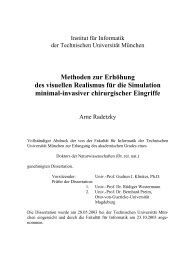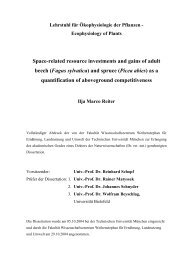Topologically Defined Neuronal Networks Controlled by Silicon Chips
Topologically Defined Neuronal Networks Controlled by Silicon Chips
Topologically Defined Neuronal Networks Controlled by Silicon Chips
Create successful ePaper yourself
Turn your PDF publications into a flip-book with our unique Google optimized e-Paper software.
Summary<br />
Small neuronal networks with defined synaptic connection patterns could provide a unique tool for<br />
studying fundamental concepts in neuroscience, because they are much simpler than in vivo systems<br />
and give easy access to individual neurons. Field-effect transistors and capacitive stimulators implemented<br />
on a semiconductor chip establish a non-invasive neuron-silicon interface, that enables the long<br />
term supervision even of large neuronal assemblies.<br />
The present thesis addresses the experimental and technological aspects of network design. Based on<br />
existing transistor chips a new device was processed for the specific requirements here. Small chipcontrolled<br />
networks were grown from neurons of the snail Lymnaea stagnalis and characterized.<br />
First, a new method for directing neurite outgrowth was developed. It is based on topographic guidance<br />
cues consisting of pits and narrow connecting grooves, which were processed from SU-8 polyester photoresist.<br />
Neurons placed into the pits grew neurites that followed the grooves and established electrical<br />
synapses upon contact with other neurites or somata. These networks were studied with standard electrophysiology<br />
and the conductance of the synapses was determined. On average, it was larger than the<br />
conductance of synapses between cell pairs grown on protein tracks.<br />
Besides guiding their outgrowth, the topographic structures also keep neurites in the final geometry<br />
and confine cell bodies to the pits. This is a major advantage compared to techniques using chemical<br />
patterns; there, neurites and somata are frequently pulled away <strong>by</strong> forces exerted <strong>by</strong> the growth-cones.<br />
Moreover, the structures are reusable many times, which makes them very efficient.<br />
Building on established technologies for extracellular recording and stimulation of neural activity, a<br />
transistor chip was processed next. Its layout, 16 bidirectional contacts arranged in a 4x4 array, was<br />
especially designed for monitoring small, defined networks of snail neurons. Each contact comprised<br />
a buried channel field-effect transistor for recording action potentials, surrounded <strong>by</strong> capacitive stimulation<br />
spots. <strong>Chips</strong> were characterized electronically and tested with single neurons. The transistors<br />
recorded a variety of signal types, similar to the results of previous works. Most of the extracellular<br />
signals could be qualitatively explained with the point-contact model for the neuron-silicon interface<br />
and the Hodgkin-Huxley model describing the voltage dynamics of the neuron. Extracellular stimulation<br />
was very reliable, 5-10 square wave pulses with 1V-5V amplitude applied to the capacitive spots<br />
evoked action potentials in the cell above.<br />
The third step combined both technologies, SU-8 topographic structures and silicon chips. For the<br />
first time, hybrid networks with defined geometry were realized. The most fundamental system, the<br />
silicon-neuron-neuron-silicon loop, was studied in detail. Upon extracellular stimulation the respective<br />
presynaptic neuron fired an action potential, which was detected <strong>by</strong> the transistor. The signal propagated<br />
along the neurites, passed the synapse and depolarized the postsynaptic cell where it triggered<br />
an action potential, if the input was strong enough. Again, neuronal activity was recorded from the<br />
transistor underneath. Larger networks with three and four neurons were also grown and characterized.<br />
The examples presented here constitute proof-of-principle experiments. They demonstrate that topologically<br />
defined hybrid networks, combining biology and semiconductor technology, can be implemented<br />
in functional systems, and pave the way for future applications such as a ‘living’ neurocomputer.
















